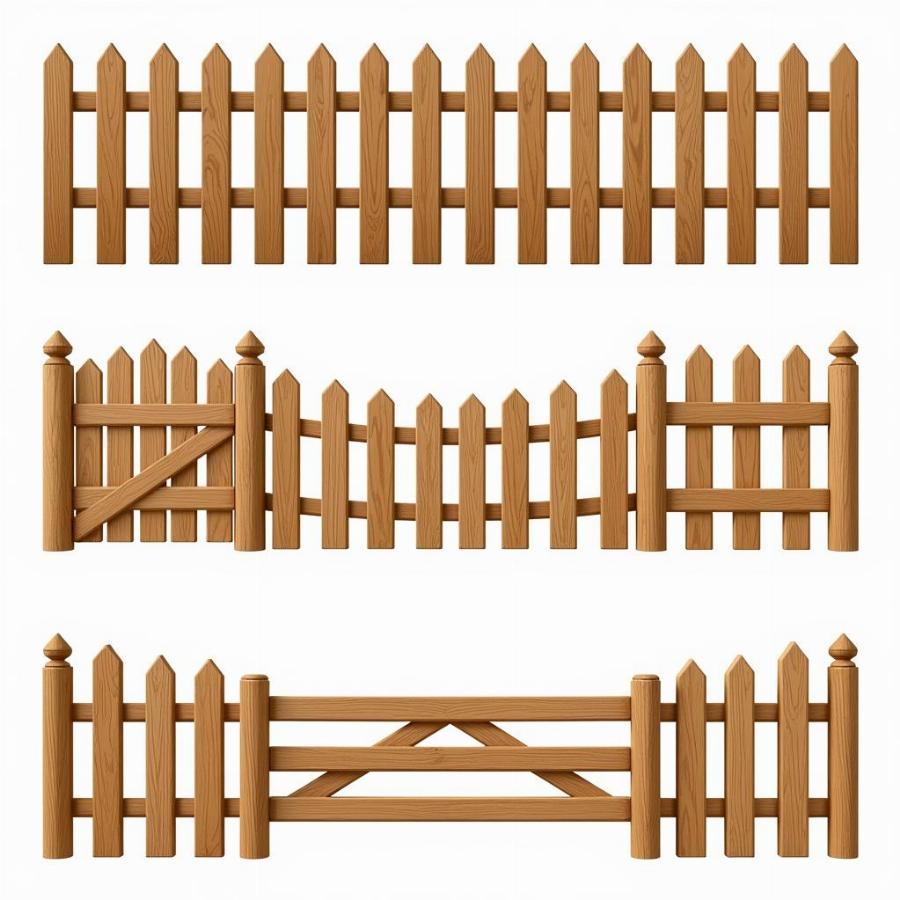A wooden dog fence offers a classic and natural look for your backyard while keeping your furry friend safe and contained. But with so many options available, how do you choose the right wooden dog fence for your needs and your dog’s? This comprehensive guide will walk you through everything you need to consider, from height and material to style and installation. Let’s dive in and explore the world of wooden dog fences.
Choosing the right fence is crucial for your dog’s safety and your peace of mind. Factors like your dog’s breed, size, and temperament play a significant role in determining the ideal fence height and design. A properly installed and maintained wooden fence can provide years of reliable service, enhancing both the aesthetics and functionality of your yard.
Key Considerations for a Wooden Dog Fence
Before rushing to buy the first fence you see, consider these important factors:
Height: Keeping Your Canine Companion Contained
The height of your fence is paramount. A small dog might be content with a shorter fence, while a larger, more athletic breed might require something considerably taller. Consider your dog’s jumping ability and propensity for digging. For jumpers, consider a higher fence or adding coyote rollers to the top. For diggers, consider burying chicken wire at the base of the fence or installing an L-footer.
Material: Durability and Aesthetics
While all wooden fences share a natural aesthetic, the type of wood used greatly impacts durability and maintenance. Pressure-treated pine is a popular and affordable option, but cedar and redwood offer greater resistance to rot and insects. Consider your local climate and budget when making this decision.
Style: Blending Form and Function
Wooden fences come in a variety of styles, from traditional picket fences to solid privacy fences. Consider your personal aesthetic preferences and your dog’s needs. A solid fence may be better for anxious dogs who are easily startled by outside stimuli, while a picket fence allows for more visibility.
Installation and Maintenance: Ensuring Long-Lasting Performance
Proper installation is essential for a secure and long-lasting wooden dog fence. Ensure the posts are set deep enough to provide stability and that the fence panels are securely attached. Regular maintenance, such as staining or sealing the wood, will protect it from the elements and extend its lifespan.
DIY vs. Professional Installation
While installing a wooden fence can be a DIY project, it’s often best to hire a professional, especially for larger or more complex designs. Professionals have the experience and equipment to ensure the fence is properly installed and meets safety standards.
Ongoing Maintenance: Keeping Your Fence in Top Shape
Regular maintenance is crucial. Inspect your fence regularly for any signs of damage, rot, or loose boards. Apply a fresh coat of stain or sealant every few years to protect the wood from the elements.
Addressing Common Concerns: Answering Your Questions
What if my dog digs under the fence? As mentioned earlier, burying chicken wire or installing an L-footer can deter digging.
What if my dog jumps the fence? Increase the fence height, add coyote rollers, or install an invisible fence as an additional barrier.
What type of wood is best for a dog fence? Cedar and redwood are naturally resistant to rot and insects, but pressure-treated pine is a more budget-friendly option.
How much does a wooden dog fence cost? The cost varies depending on the size of your yard, the type of wood, and the complexity of the design.
 Different Wooden Fence Styles for Dog Owners
Different Wooden Fence Styles for Dog Owners
Conclusion: Securing Your Furry Friend with the Perfect Wooden Fence
Choosing the right wooden dog fence involves careful consideration of your dog’s needs, your budget, and your aesthetic preferences. By following the guidelines outlined in this guide, you can create a safe and beautiful space for your beloved companion to enjoy. Remember, a well-chosen and properly maintained wooden fence can provide years of reliable service, enhancing both the safety and beauty of your home.
FAQ
- What is the ideal height for a wooden dog fence? It depends on the size and breed of your dog, but generally, a fence between 4 and 6 feet tall is sufficient.
- How do I prevent my dog from digging under the fence? Bury chicken wire at the base or install an L-footer.
- What type of wood is most durable for a dog fence? Cedar and redwood are highly durable.
- Can I install a wooden dog fence myself? Yes, but professional installation is often recommended.
- How often should I maintain my wooden dog fence? Inspect it regularly and apply a fresh coat of stain or sealant every few years.
- Are there any safety concerns with wooden dog fences? Ensure the wood is treated to prevent splinters and that there are no gaps or protruding nails.
- What are coyote rollers? These are angled rollers attached to the top of the fence, making it difficult for dogs to climb over.
You might also be interested in reading our articles on yard fence for dogs and dog signs for yard.
Beaut Dogs is your ultimate resource for all things related to dog ownership, providing reliable and in-depth information to help you care for your canine companion. From breed guides to training tips, we’ve got you covered. For personalized assistance, contact us at [email protected]. We’re here to help! Visit us at https://beautdogs.com.